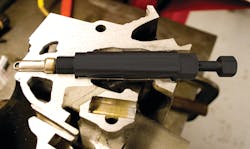423246 Vehicle Application:
- 2005 Expedition 5.4L
- 2005 F-150 5.4L
- 2006 F-150 5.4L
Customer Concern:
The engine has a bad misfire, it sets codes P0300, P0301, P0302, P0303, P0304 and P0316. Injectors and coils have been swapped bank to bank with no change in conditions or codes.
Average Reported Mileage:114,130
Tests/Procedures:
- Before extensive testing, it should be noted there are updated spark plugs for this engine that will many times repair this condition and others similar to it. NOTE: In this case, the updated spark plugs resolved the concern.
- NOTE: Be aware the spark plugs in this engine may break off in the head. Let the engine get hot, remove all coils, soak penetrant oil in the hole, barely crack loose each plug, then allow to soak overnight. The plugs may still break off, but this procedure is sometimes helpful. Also see the TSB 08-7-6 for spark plug removal instructions if they do break off.
- If the condition is still present, continue with normal diagnosis.
Several special tools have been developed to deal with specific problems occurring on Ford Triton overhead cam engines built since 1991. Often called “Modular” engines because of the design of the engine manufacturing plants (even some service bulletins call them Modular), the family includes 4.6L and 5.4L 8-cylinder engines and the 6.8L 10-cylinder engine, all made in 2- 3- and 4-valve configurations. Some of the special tools developed for these engines address three specific jobs: misfire diagnosis, spark plug extraction and spark plug hole thread repair.
Misfire Diagnosis
The early Ford Coil-on-Plug (COP) ignition systems were notorious for misfire, and while they’re a lot better today, the large number of failures hastened development of new misfire diagnostic tools. Before replacing the spark plugs, these tools make it a lot easier to determine if the ignition system is functioning properly.
To find the source of a constant misfire, scan tools are still among the most powerful diagnostic aids. But even if you’re proficient with scan tool Mode $06 (and not many folks are), a scan tool by itself often isn’t enough to track down a random misfire on these engines.
Since COP ignition has no spark plug wires, many COP diagnostic tools work by accessing the primary ignition signal. The primary signal mirrors the secondary but at a much lower voltage, so watching that signal presents a complete and accurate picture of what’s happening at the tip of the spark plug.
Some testers use a probe that actually pierces the primary circuit wire. Low-current inductive probes eliminate the corrosion risk created by piercing wires, but there are some situations where piercing may still be preferable. Either way, performing diagnostics on the primary ignition circuit provides several advantages:
- If the coils are buried, you can work with the primary circuit in a more accessible part of the wiring harness.
- No special adapters are needed, just one probe.
- When using a piercing probe, you can disable the coil for cylinder-kill testing.
- With the probe connected to an oscilloscope, the appearance of the waveform will be consistent on all engines, and it’s a cleaner signal that’s easier to analyze.
- When using an oscilloscope, you can also look at triggering, power consumption and other events that wouldn’t show up by just looking at the ignition secondary.
A more recent generation of COP diagnostic tools uses an inductive pickup that just needs to touch or be held close to the coil itself. They’ll show you spark plug firing voltage, burn time, engine RPM and more. On some engines the coils are buried, so if you’re more interested in a quick go/no-go check rather than detailed diagnostics, tools like this can save a lot of time.
Spark Plug Extraction
The Ford Triton 3-valve engines use COP ignition along with a unique spark plug design. The tip extends a full inch (25mm) below the seat, and it’s enclosed in a heavy-gauge stainless-steel sheath that includes the ground electrode. Above that, the tapered seat is a larger diameter (mild) steel ring extending 1/2" (13mm) below the threads. The design is intended to keep the threads away from the heat of the combustion chamber.
Unfortunately, carbon deposits build up between the extended sheath and the cylinder head. Attempting to remove the spark plug without first dissolving that carbon will cause the plug to break off just below the threads, leaving the seat ring, ceramic tip and sheath stuck fast in the hole. Sometimes the threads in the cylinder head are damaged too. Fortunately, there are tools and procedures for extracting these pieces and repairing the threads without removing the cylinder head.
Many service bulletins have been issued to address this problem. The most important bulletin is 08-1-9, which explains how to remove the spark plugs without breaking them. Many people report success using that procedure. The latest bulletin describing the extraction procedure and tools is 08-7-6, and TSB 07-21-2 describes latest thread repair procedure and tools.
The Ford spark plug extractor tool is Rotunda 303-1203, also known as the OTC 303-1203. Other well-known vendors make tools designed for the same job, and while some are a little easier to use, each will get the job done. The step-by-step instructions are pretty clear and helpful, but we have learned a few tips from the field.
First of all, follow the instructions carefully; don’t rush the job or omit any steps. The first steps will remove or push the broken porcelain down into the end of the sheath, making room for the extractor tool. Secondly, get some heat into the broken sheath. One user of this tool ground down a length of all-thread rod to fit precisely into the sheath, using the sheath from one of the other old plugs to check the fit. Then he heated the rod with a torch and inserted it into the sheath.
Once the extractor gets a good bite on the sheath, it still might not move. A VERY slight tap may break it loose. Remember, it’s the carbon built up around the sheath that’s holding it in place.
Thread Repair
Triton engines are also known for spark plug thread failures, to the point of actually spitting the plug out of the engine. Ford TSB 07-21-2 provides information about a Rotunda tool for repairing the threads without removing the cylinder head, and Ford also approves the use of a Lock-n-Stitch Full-Torque thread repair kit. This kit has hardened aluminum inserts that are stronger than the original threads, and Ford says they provide the proper heat transfer from the spark plug. The kit will work on all Triton (Modular) engines made since 1991.
The kit’s instructions are complete and well illustrated. One item that requires special attention is measuring the spark plug hole seat.
Three different seat shapes were used in these engines, and there are different inserts for each seat shape. The only way to tell which insert to use is to measure the undamaged seat of another spark plug hole with a special gauge provided in the kit. The gauge and the measuring process are complicated, so follow the instructions carefully. There is more information on the company’s website and even a few user-generated videos on YouTube.
Several other tools are available for working on this family of engines, some that provide speed and convenience, and some that make otherwise impossible repairs possible. Search the Product Guide on our Website (www.vehicleservicepros.com)
About the Author

Jacques Gordon
Jacques Gordon is the former editor-in-chief of PTEN and Professional Distributor magazines. His background includes 10 years as an automotive technician and 10 years in Tier 1 suppliers’ engineering labs testing gaskets, fuel injection systems and emission control systems.
He continues to stay abreast of the latest technical developments through editorial research and technician training seminars. He holds an ASE Master Technician with L1 Certification and a Master Hybrid Technician certification from ACDC.
Jacques has been writing for aftermarket magazines since 1998, and he has earned a reputation as one of the best technical writers in the business. He is a winner of two American Society of Business Press Editor awards and several company editorial awards.
He is currently the video script writer for the CARS Training Network in Ontario, Canada.
Connect with him on LinkedIn.
